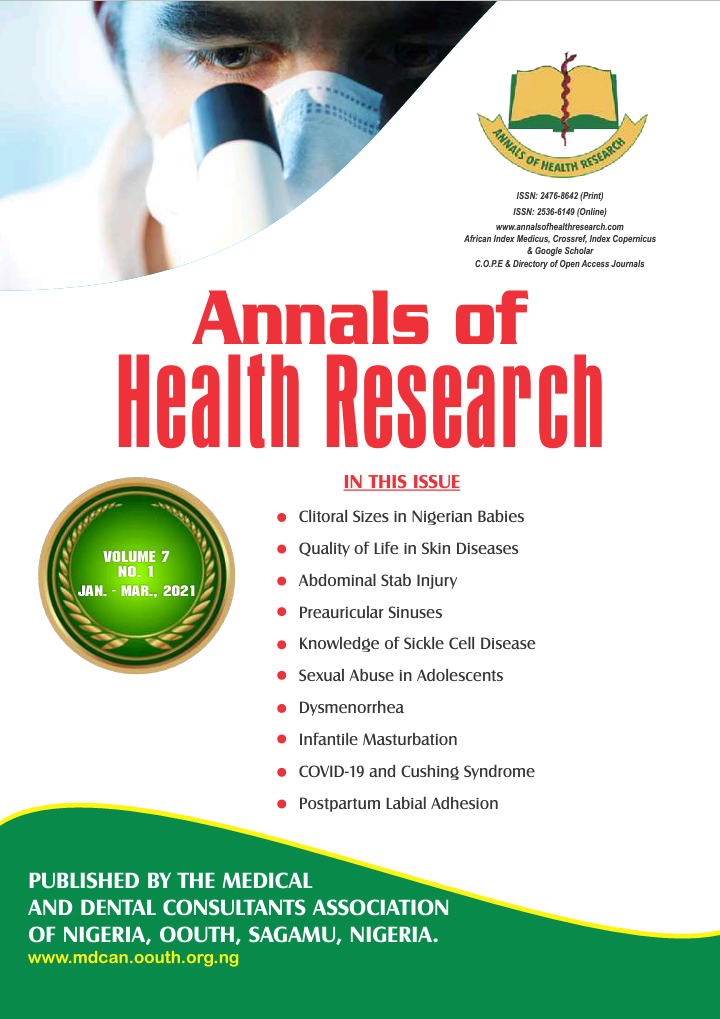Sexual Abuse Among Adolescents
DOI:
https://doi.org/10.30442/ahr.0701-06-115Keywords:
Abuse, Adolescent, Knowledge, Nigeria, Sexual abuse, Sexual assaultAbstract
Background: Adolescence constitutes a vulnerable age group where the actual prevalence of sexual abuse may remain largely unknown due to lack of knowledge, delay in and lack of reporting of such incidences.
Objectives: To determine the knowledge and history of sexual abuse in adolescents and the associated factors.
Methods: A self-administered pretested questionnaire was used to collect data from children aged 10 to 19 years at an adolescent summer camp.
Results: Two hundred and seventy-six adolescents participated in this research out of which 41.3% had correct knowledge of sexual abuse, and 12.0% claimed they had been sexually abused. Among the 33 respondents with a history of sexual abuse, 39.4% (13/33) had correct knowledge of sexual abuse. Gender had a significant association with a history of sexual abuse (p = 0.008). Layered by age group, gender had a significant association with being sexually abused in mid-adolescence (p = 0.029) but not in late adolescence (p = 0.445). Age category had no significant association with being sexually abused.
Conclusion: The knowledge of sexual abuse was inadequate among adolescents. A high proportion claimed to have been previously sexually abused and interestingly, had insufficient knowledge of sexual abuse There is a need to educate adolescents on sexual abuse to empower them to protect themselves and get help as appropriate.
References
American Psychology Association. Sexual Abuse. [Cited 2020 July]. Available from: https://www.apa.org/topics/sexual-abuse
Kempe CH. Sexual abuse, another hidden pediatric problem: the 1977 C. Anderson Aldrich Lecture. Pediatrics 1978; 62: 382–389.
Kellogg N. The evaluation of sexual abuse in children. Pediatrics 2005; 116: 506–512. https://doi.org/10.1542/peds.2005-1336
World Health Organization. Responding to Children and Adolescents who have been Sexually Abused. 2017 October. [Accessed 2019 September]. Available from: https://www.who.int/reproductivehealth/topics/violence/clinical-response-csa/en/
Yahaya I, Soares J, De Leon AP, Macassa G. A comparative study of the socioeconomic factors associated with childhood sexual abuse in sub-Saharan Africa. Pan Afr Med J. 2012; 11: 51.
Manyike PC, Chinawa JM, Aniwada E, Udechukwu NP, Odutola OI, Chinawa TA. Child sexual abuse among adolescents in southeast Nigeria: A concealed public health behavioral issue. Pak J Med Sci 2015; 31: 827–832. doi: http://dx.doi.org/10.12669/pjms.314.7115
David N, Ezechi O, Wapmuk A, Gbajabiamila T, Ohihoin A, Herbertson E, et al. Child sexual abuse and disclosure in Southwestern Nigeria: a community-based study. Afri Health Sci 2018; 18: 199–208. https://doi.org/10.4314/ahs.v18i2.2
Ogunfowokan AA. Experiences of Sexual Abuse by School Adolescent Girls in Ile – Ife, Nigeria. Semantic scholar. [Accessed 2019 September]. Available from: https://pdfs.semanticscholar.org/47d8/04d5e9f81f10745aab75e3c84269b9814e52.pdf
Lalor K. Child sexual abuse in sub-Saharan Africa: A literature review. Child Abus Negl. 2004; 28: 439–460. https://doi.org/10.1016/j.chiabu.2003.07.005
Moore AM, Awusabo-Asare K, Madise N, John-Langba J, Kumi-Kyereme A. Coerced first sex among adolescent girls in sub-Saharan Africa: prevalence and context. Afr J Reprod Health. 2007; 11: 62–82. https://doi.org/10.2307/25549732
Act for Youth. Adolescent identity development. Available from: http://www.actforyouth.net/adolescence/identity.cfm Accessed July 2020.
Upreti R. Identity Construction: An Important Issue Among Adolescents. IOSR J Human Soc Sci 2017; 22 :54 – 57. https://doi.org/10.9790/0837-2206105457
Vannucci A, Simpson BG, Gagnon S, Ohannessian CM. Social media use and risky behaviour in adolescence: A meta-analysis. J Adolesc 2020; 79: 258–274. https://doi.org/10.1016/j.adolescence.2020.01.014
Landry M, Turner M, Vyas A, Wood S. Social Media and Sexual Behaviour Among Adolescents: Is there a link? JMIR Public Health Survell 2017; 3: e28.
Burstein GR. The Epidemiology of Adolescent Health Problems. In: Kliegman RM, Stanton BF, St. Geme JW, Schor NF, Behrman RE (Editors). Nelson Textbook of Paediatrics [Electronic copy]. 20th Edition. Philadelphia. Elsevier; 2016.
Lehtimaki S, Schwalbe N, Sollis L. Adolescent Health: The Missing Population in Universal Health Coverage. World Health Organization. 2018.
Eze UO. Prevention of Sexual Assault in Nigeria. Ann Ib Postgrad Med 2013; 11: 65–70.
Trickett PK, Noll JG, Putnam FW. The impact of sexual abuse on female development? Lessons from a multigenerational, longitudinal research study. Dev Psychopathol 2011; 23: 453–476. https://doi.org/10.1017/S0954579411000174
Australian Institute of Family Studies. The long-term effect of child sexual abuse. Australian Government. 2013. [Cited 2020 August]. Available from: https://aifs.gov.au/cfca/publications/long-term-effects-child-sexual-abuse/gender-differences-long-term-impacts-child-sexual
Holland-Hall C, Burstein GR. Adolescent Physical and Social Development (Adolescent Development). In: Kliegman RM, Stanton BF, St. Geme JW, Schor NF, Behrman RE (Editors). Nelson Textbook of Paediatrics [Electronic copy]. 20th Edition. Philadelphia. Elsevier; 2016.
Kipping RR, Campbell RM, MacArthur GJ, Gunnell DJ, Hickman M. Multiple risk behaviour in adolescence. J Public Health 2012; 34: i1–i2. https://doi.org/10.1093/pubmed/fdr122
Downloads
Published
Issue
Section
License
The articles and other materials published in the Annals of Health Research are protected by the Nigerian Copyright laws. The journal owns the copyright over every article, scientific and intellectual materials published in it. However, the journal grants all authors, users and researchers access to the materials published in the journal with the permission to copy, use and distribute the materials contained therein only for academic, scientific and non-commercial purposes.


